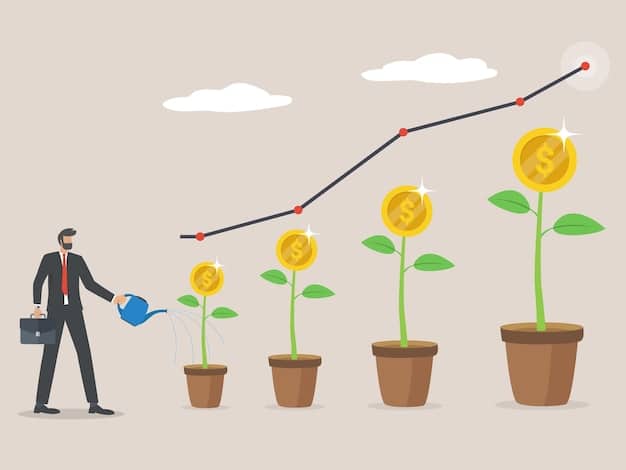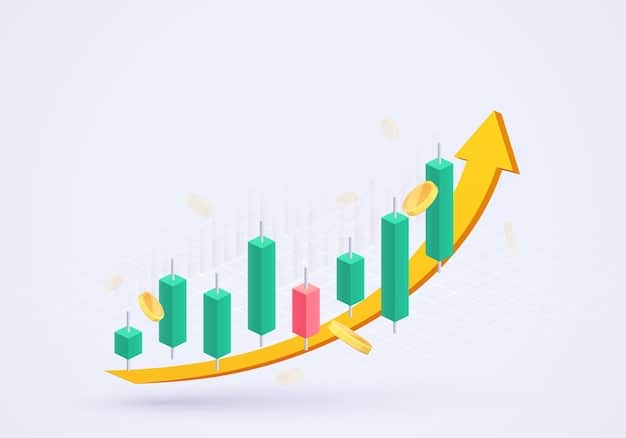
Growth investing is a strategy that involves investing in companies anticipated to grow at a faster rate than the average company in the market. Investors who follow this strategy aim to benefit from the high returns these companies can offer.
However, as with any investment strategy, growth investing comes with its own set of risks and rewards and investors need to understand these dynamics to make smart decisions.
This article explores the complexities of growth investing, examining the pros & cons and the impact of market fluctuations on investment decisions.
Rewards Of Growth Investing
Capital Appreciation
The most compelling reward of growth investing is the potential for significant capital appreciation. Growth stocks, typically representing companies that are expanding rapidly, can see their stock prices increase substantially over time.
These companies reinvest their earnings to fuel further growth and reinvest profits, rather than paying dividends, which can result in higher stock prices as the market anticipates future profitability. For investors, this can translate into substantial returns on their investments, especially when they identify and invest in such companies early in their growth trajectories.

Market Outperformance
Another notable reward of growth investing is the potential to outperform the broader market. Historically, growth stocks have shown the ability to deliver higher returns compared to other types of stocks, particularly during periods of economic expansion and technological innovation.
This outperformance is often driven by the ability of growth companies to capture significant market share through innovation and effective business strategies. As these companies continue to grow and expand, their stock prices reflect high growth potential and their increasing market dominance, leading to enhanced returns for investors.
Innovation and Market Leadership
Growth companies are often at the forefront of innovation, developing new products and services that disrupt traditional markets and create new opportunities. This innovation can lead to market leadership, where the company secures a strong competitive position that is difficult for competitors to challenge.
Investors in these companies benefit from the rapid growth that accompanies successful innovation and market leadership.
Long-Term Financial Growth
Investing in growth stocks can lead to substantial long-term financial growth due to the compounding effect of reinvested earnings and capital gains. For investors with a long-term investment horizon, the growth in stock prices can accumulate significantly over time.
This compounding effect is particularly powerful when investors identify and hold onto growth stocks that continue to expand their market presence and profitability.

Risks of Growth Investing
High Valuation Risk
One of the primary risks associated with growth investing is high valuation risk. Growth stocks often trade at elevated price-to-earnings (P/E) ratios, which reflect high investor expectations for future growth. When these expectations are not met, stock prices can experience sharp declines.
Overvaluation can lead to speculative bubbles, where the market price of growth stocks becomes disconnected from their fundamental value. When these bubbles burst, the resulting corrections can cause significant financial losses for investors who bought in at inflated prices.
Market Fluctuation
Growth stocks are inherently more unpredictable than their value counterparts. The high expectations for future growth lead to greater sensitivity to market sentiment and economic conditions. Prices of growth stocks can swing dramatically based on news, quarterly earnings reports, or broader market movements.
This volatility and market swings can be unsettling for investors, especially those with lower risk tolerance. Moreover, growth stocks can be particularly sensitive to changes in interest rates; rising rates can increase borrowing costs for these companies and reduce the present value of their future earnings, leading to price declines.

Company-Specific Risks
Growth investing also involves substantial company-specific risks. Growth companies are often in earlier stages of their business cycles, making them more vulnerable to operational challenges and management missteps. Execution risk is high, as these companies need to continually innovate and scale their operations to meet growth expectations.
Competitive pressures can also pose a threat; failure to maintain a competitive edge can result in lost market share and diminished growth prospects. Additionally, the aggressive reinvestment strategy often adopted by growth companies can lead to higher debt levels, increasing financial risk if growth does not materialize as expected.
Economic and Sector Risks
Economic and sector risks are significant considerations in growth investing. Growth stocks can be particularly vulnerable during economic downturns, as reduced consumer spending and business investment can negatively impact their growth prospects. Furthermore, growth investing often involves concentration in specific sectors like technology or biotechnology, which can be subject to rapid regulatory changes, technological advancements, and sector-specific challenges.
These sector-specific risks can amplify the volatility and risk associated with growth stocks, making it essential for investors to stay informed about industry trends and potential regulatory impacts.
Limited Income Generation
A potential drawback of growth investing is the limited income generated from these investments. Growth companies typically reinvest their profits into the business to fuel further expansion, resulting in little to no dividends for shareholders. This can be a disadvantage for investors seeking regular income from their investments.
The focus on capital appreciation over income generation means that investors may need to rely on selling shares to realize gains, which can introduce timing risk. This aspect makes growth stocks less attractive for income-focused investors, who might prefer more stable dividend-paying stocks.
Balancing Risks and Rewards in Growth Investing
Thorough Research and Due Diligence
Balancing the risks and rewards in growth investing starts with thorough research. It’s all about digging deep into a company’s financial health like looking at revenue growth, profit margins, cash flow, and debt levels. You need to understand how the company makes money and what sets it apart from the competition. Also, get a sense of the management team’s vision and track record. This can give you a clearer picture of the company’s growth potential.
Risk Management Strategies
Managing risk is crucial. One way to do this is through position sizing—don’t let any single investment take up too much of your portfolio. This way, if one stock tanks, it won’t hurt as much. Another strategy is using stop-loss orders to sell stocks automatically if they drop to a certain price, helping you avoid emotional decisions. Hedging with options or short selling can also protect your investments. These strategies ensure you’re investing within your risk tolerance.
Regular Portfolio Review and Rebalancing
Keep your portfolio in check by reviewing and rebalancing it regularly. This means staying on top of your investments and making adjustments to keep things aligned with your goals and risk tolerance. If some stocks have done well, consider selling some and buying others that might be undervalued. This process helps you stay adaptable to market fluctuations and changes within specific companies.
Combining Investment Strategies
Mixing growth investing with other strategies can provide balance. Pairing growth stocks with value stocks can give you high returns and stability during economic downturns. Adding dividend-paying stocks offers steady income, which can be a nice counterbalance to the higher risk of growth stocks. Diversifying beyond stocks, like including bonds or real estate, can further reduce risk. This blended approach helps manage the pros and cons of growth investing and leads to a more stable portfolio.
Balancing the pros and cons of growth investing involves a thoughtful mix of thorough research, effective risk management, regular reviews, and smart diversification of investment goals. By doing this, you can tap into growth potential while handling market fluctuations and staying within your risk tolerance.
Conclusion
Growth investing offers the potential for high returns through capital appreciation and market outperformance, driven by innovative and market-leading companies. However, it also entails significant risks, including high valuation risk and company-specific challenges among others.
By understanding all risks and rewards, investors can make wise decisions and implement strategies to balance assets with the potential for high returns with the need to manage and reduce risks.




